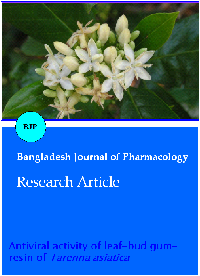Antiviral activity of leaf-bud gum-resin of Tarenna asiatica
DOI:
https://doi.org/10.3329/bjp.v9i3.19707Keywords:
Leaf-bud exudate, corymbosin, Tarenna asiatica, antiviral - animal and plant, ELISA and PCR methodsAbstract
The leaf-bud exudate of Tarenna asiatica (Rubiaceae: Ixoroideae, Pavetteae) is investigated for its biological activity. The crude benzene extract and corymbosin (pure compound isolated) were screened for antiviral activity by using ELISA and PCR methods against animal (blue tongue and chikungunya) and plant (papaya ring spot, sesbania mosaic and common bean mosaic) viruses. Both corymbosin and benzene extract showed significant antiviral activity though corymbosin was found relatively more potent against the animal and plant viruses tested. This is the first report of antiviral activity for the gum-resin of T. asiatica, so also for the compound corymbosin, against the plant viruses.
Downloads
574
336 Read
288
References
Amutha D, Shanthi S, Mariappan V. Antiinflammatory effect of Tarenna asiatica in carrageenan induced lung inflammation. Int J Pharm Pharmaceut Sci. 2012; 4: 344- 47.
Anjanadevi N, Menaga S. Wound healing potential of Tarenna asiatica leaves. J Theor Exp Biol. 2013; 10: 75-80.
Anonymous. The wealth of India: Raw materials. New Delhi, Council of Scientific and Industrial Research, 1976, pp 130-31.
Barros AV, Conceição AO da, Simoni IC, Arns CW, Fernandes MJB. Mechanisms of antiviral action of seeds from Guettarda angelica Mart. against bovine and swine herpes viruses in vitro. Virus Reviews Res. 2010; 15: 78-91.
Barros AV, Conceição AO da, Simoni IC, Padilla MA, Fernandes MJB, Arns CW. In vitro antiviral activity of seeds from Guettarda angelica against avian viruses. J App Pharmaceut Sci. 2013; 3: 31-33.
Donia M, Hamann, MT. Marine natural products and their potential applications as anti-infective agents. Lancet Infect Dis. 2003; 3: 338-48.
Edziri HL, Smach MA, Ammar S, Mahjoub MA, Mighri M, Aouni M, Mastouri M. Antioxidant, antibacterial and antiviral effects of Lactuca sativa extracts. Industrial Crops Products. 2011; 34: 1182-85.
Jayasinghe ULB, Jayasooriya CP, Bandara BMR, Ekanayake SP, Merlini, Assante LG. Antimicrobial activity of Sri Lankan Rubiaceae and Meliaceae. Fitoterapia. 2002; 73: 424-27.
Qamar MT ul, Mumtaz A, Ashfaq UA, Adeel MM, Fatima T. Potential of plant alkaloids as dengue ns3 protease inhibitors: Molecular docking and simulation approach. Bangladesh J Pharmacol. 2014; 9: 262-67.
Rajakaruna N, Harris CS, Towers GHN. Antimicrobial activity of plants collected from serpentine outcrops in Sri Lanka. Pharmaceut Biol. 2002; 40: 23544.
Ramabharathi V. Phytochemical investigation of gum-resin of Tarenna asiatica and evaluation of its biological activities. M. Pharm. Dissertation. Sri Padmavati Mahila Visvavidyalayam (Womens University), Tirupati, 2011.
Ramabharathi V, Apparao AVN, Rajith G. Phytochemical investigation and evaluation of antibacterial and antioxidant activities of leaf-bud exudate of Tarenna asiatica (L.) Kuntze ex K. Schum. Indian J Nat Prod Resour. 2014; 5: 48-51.
Ramabharathi V, Schuehly W. How to deal with nomenclatorial ambiguities of trivial names for natural products? A clarifying case study exemplified for corymbosin. Nat Prod Comm. 2014; 9: 57-60.
Ramarao N, Henry AN. The Ethnobotany of Eastern Ghats in Andhra Pradesh, India. Calcutta, Botanical Survey of India, 1996.
Rao DM, Rao UVUB, Sudharshanam D. Ethno-medicobotanical studies from Rayalaseema region of southern Eastern Ghats, Andhra Pradesh, India. Ethnobotanical Leaflets. 2006; 10: 198-207.
Reis SRIN, Valente LMM, Sampaio AL, Siani AC, Gandini M, Azeredo EL, DAvila LA, Mazzei JL, Henriques MGM, Kubelka CF. Immunomodulating and antiviral activities of Uncaria tomentosa on human monocytes infected with Dengue Virus-2. Int Immunopharmacol. 2008; 8: 46876.
Saigopal DVR, Prasad VS, Srinivasulu P. Antiviral activity in extracts of Phyllanthus fraternus Webst. (P. niruri). Curr Sci. 1986; 55: 264-65.
Sunday OA, Munir AB, Akeeb OO, Bolanle AA, Badaru SO. Antiviral effect of Hibiscus sabdariffa and Celosia argentea on measles virus. African J Microb Res. 2010; 4: 293-96.
Vinothkumar D, Murugavelh S, Prabhavathy AK. Phytosociological and ethnobotanical studies of sacred groves in Pudukottai district, Tamil Nadu, India. Asian J Exp Biol Sci. 2011; 2: 306-15.
Williams JE. Review of antiviral and immunomodulating properties of plants of the Peruvian rainforest with a particular emphasis on Una de
Gato and Sangre de Grado. Altern Med Rev. 2001; 6: 567-79.
Zandi K, Zadeh MA, Sartavi K, Rastian Z. Antiviral activity of Aloe vera against herpes simplex virus type 2: An in vitro study. African J Biotech. 2007; 6: 1770-73.

Published
How to Cite
Issue
Section
License
Authors who publish with this journal agree to the following terms:
- Authors retain copyright and grant the journal right of first publication with the work simultaneously licensed under a Creative Commons Attribution License that allows others to share the work with an acknowledgement of the work's authorship and initial publication in this journal.
- Authors are able to enter into separate, additional contractual arrangements for the non-exclusive distribution of the journal's published version of the work (e.g., post it to an institutional repository or publish it in a book), with an acknowledgement of its initial publication in this journal.
- Authors are permitted and encouraged to post their work online (e.g., in institutional repositories or on their website) prior to and during the submission process, as it can lead to productive exchanges, as well as earlier and greater citation of published work (See The Effect of Open Access).
